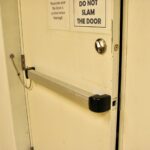 The more of the “vanilla” topics that are covered on iDigHardware, the more “peppermint stick” the questions become!
The more of the “vanilla” topics that are covered on iDigHardware, the more “peppermint stick” the questions become!
Helipads/heliports are becoming more common on the rooftops of hospitals and office buildings. So how are security and egress handled? I found an FAA document on hospital heliports, which doesn’t tell us much about the doors except that access to the heliport must be secured to prevent unauthorized people from wandering into the landing zone. When we’re talking about a heliport on a rooftop, this means that the doors leading from the building to the heliport are secured on the inside.
The egress requirements for heliports and helistops are addressed by the International Building Code (IBC); Section 412.7.3 (2018 edition) states that the means of egress shall comply with Chapter 10. This chapter contains the egress requirements that apply to other egress doors – required clear opening width, hardware operation, opening force, closing speed, etc. When the landing area is located on a building, at least 2 means of egress are required; if the landing area is less than 60 feet long or less than 2,000 square feet in area, one of the two means of egress can be a fire escape, alternating tread device, or ladder leading to the floor below.
The IBC requires rooftop heliports and helistops to comply with NFPA 418 – Standard for Heliports. In the egress section, this standard requires two means of egress from the landing pad to the building’s egress system, and specifies that the egress points must be located at least 90 degrees from each other, measured from the center of the landing pad. The egress points must be at least 30 feet apart, and no two egress points can be located on the same side of the landing pad. The means of egress must be located so that use of the egress routes will not obstruct flight operations. There is more information in Annex A, including diagrams of allowable egress configurations.
The question that prompted this research was about the hardware required for the doors leading from the building to the heliport. Is panic hardware required? Can electromagnetic locks be used? The IBC, NFPA 418, and the FAA document don’t get into detail about the hardware. But unless the heliport is used as assembly space (not typical), the doors wouldn’t require panics. Panic hardware may be desired for ease of use and durability, but it is not required by code. Electromagnetic locks can be used, as long as all of the requirements of the applicable code section are met. The important consideration is that the doors have to allow free egress from the heliport side, and be secured from the opposite side. If the doors are fire-rated, they will be required to latch.
Do any of you have experience specifying, supplying, or installing doors and hardware for a heliport? Any insight to add?
You need to login or register to bookmark/favorite this content.






I have installed hardware on these types of doors . They have had both depending on design lever,or panic they allow access into the building but are alarmed or monitored. Closures are mounted top jamb but in warmer climates i have seen parallel arm . In other words on the exterior of the door Usually they enter into an open area then that area has typical fire exit stairwell doors